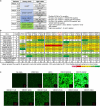A matrix of structure-based designs yields improved VRC01-class antibodies for HIV-1 therapy and prevention
- PMID: 34328065
- PMCID: PMC8331036
- DOI: 10.1080/19420862.2021.1946918
A matrix of structure-based designs yields improved VRC01-class antibodies for HIV-1 therapy and prevention
Abstract
Passive transfer of broadly neutralizing antibodies is showing promise in the treatment and prevention of HIV-1. One class of antibodies, the VRC01 class, appears especially promising. To improve VRC01-class antibodies, we combined structure-based design with a matrix-based approach to generate VRC01-class variants that filled an interfacial cavity, used diverse third-complementarity-determining regions, reduced potential steric clashes, or exploited extended contacts to a neighboring protomer within the envelope trimer. On a 208-strain panel, variant VRC01.23LS neutralized 90% of the panel at a geometric mean IC80 less than 1 μg/ml, and in transgenic mice with human neonatal-Fc receptor, the serum half-life of VRC01.23LS was indistinguishable from that of the parent VRC01LS, which has a half-life of 71 d in humans. A cryo-electron microscopy structure of VRC01.23 Fab in complex with BG505 DS-SOSIP.664 Env trimer determined at 3.4-Å resolution confirmed the structural basis for its ~10-fold improved potency relative to VRC01. Another variant, VRC07-523-F54-LS.v3, neutralized 95% of the 208-isolated panel at a geometric mean IC80 of less than 1 μg/ml, with a half-life comparable to that of the parental VRC07-523LS. Our matrix-based structural approach thus enables the engineering of VRC01 variants for HIV-1 therapy and prevention with improved potency, breadth, and pharmacokinetics.
Keywords: Antibody VRC01; HIV-1 envelope trimer; broadly neutralizing antibody; matrix-based design; polyreactivity; prophylaxis; treatment.
Conflict of interest statement
No potential conflict of interest was reported by the author(s).
Figures






References
Publication types
MeSH terms
Substances
Grants and funding
LinkOut - more resources
Full Text Sources
Other Literature Sources
Medical
